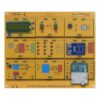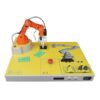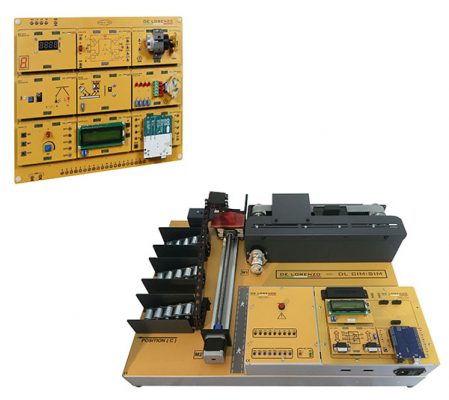INDUSTRY 4.0
KIT FOR THE STUDY OF A CONVEYOR BELT
DL CIM-SIM
The trainer for the study of a conveyor belt is composed of two main elements:
• A boards kit to study the hardware characteristics and the control techniques of a conveyor belt. The secondary boards include all the components, sensors and actuators needed to understand and manage the operation of a conveyor belt.
• Real hardware simulator of a conveyor belt unit used in a real industrial environment. Through this simulator, the student can learn how to operate and control a production line by using a PLC and an open source micro-controller. Its structure allows the connection of the board kit components, making them compatible with each other.
The design and construction of electronic circuits to solve practical problems is an essential technique in the fields of electronic engineering and computer engineering.
With this training system, students can learn about the properties of a conveyor belt used in industrial environments. Sensors and actuators are included to develop a complete course on the main features of conveyor systems and their applications.
The student will be able to interact with the hardware in a simple and intuitive way through a CAI software that explains step by step how the system works.
The integration of a conveyor belt system in an industrial process is possible using a SCADA software for the study of automation and industry 4.0 concepts.
INDUSTRY 4.0
System description:
BOARDS KIT
LEARNING EXPERIENCES
Kit composed of sub-boards for the propaedeutic study of the different elements that compose a conveyor belt system. The sub-boards can interact with each other through a dedicated motherboard, allowing the student to perform interactive practices on different topics related to automation such as:
• Controlling an LCD display through a microcontroller
• Detect an object using an infrared sensor.
• Monitoring a RGB sensor.
• Controlling a DC motor through a power driver.
• Controlling a stepper motor
• Action control and interlock function using a push button panel.
• Writing on a seven segment display
CIRCUIT BLOCKS
• Base board
• LCD display mini board
• DC motor driver mini board
• DC motor mini board
• Inputs mini board
• Seven segment display mini board
• Stepper motor mini board with driver
• IRD sensor mini board
• RGB sensor mini board
• Micro-controller mini board
INDUSTRY 4.0
HARDWARE SIMULATOR
DIDACTIC EXPERIENCE
This system is mainly used for teaching, demonstrating and experimenting with different control methods of a conveyor belt.
The student will improve the skills necessary for HW designing and SW programming of an electromechanical system.
A real PLC (supplied with the trainer) controls the sequential operation of the system, as in real automated processes, allowing the development, implementation and optimization of an application in the industrial field:
• Controlling a conveyor belt through a push button panel.
• Using a PLC to control the conveyor belt movement.
• Monitoring and identifying a processed part on the conveyor belt.
• Tracking the position of a part placed on the conveyor belt.
• Identifying and verifying the colour of a part.
• Identifying a defective part and placing it in the correct location at the end of the line.
Possibility of interfacing with SCADA monitoring software when used with DL SCADA IND4.0 kit.
TECHNICAL FEATURES
• Power supply: 90V-230V ±10%, 50/60Hz
• DC motor driving the belt: o Speed: 10 rpm
o Nominal voltage: 12Vdc
• Stepper motor linear actuator: o Nominal voltage: 12Vdc
• Servo motor:
o Nominal voltage: 5Vdc
• Control box including: o Motor drivers.
o Sensor and actuators input and outputs accessible through 2mm connectors.
o Slots to insert system sub-boards.
• Compatible with Arduino UNO boards: o ATMEGA328 Processor
o 32KB flash memory o 1KB EEPROM memory o 2KB SRAM memory
o 23 general purpose I/O ports
• IR position sensors
• RGB Sensor
• RFID detector
INDUSTRY 4.0
ACCESSORY INCLUDED:
DL 2110AM
ACCESSORY NEEDED:
DL 2555ALG
Programmable logic controller 12/10
PLC inputs:
• 8 digital inputs
• 4 digital/analog inputs PLC outputs:
• 8 relay outputs
• 2 analog outputs (V/I outputs selectable)
Two voltage output 0-10 V controlled by potentiometer.
12 digital level switches
8 LEDs for displaying output states
24 VDC Fixed voltage output Programmable by USB port Communication: Modbus RTU RS485
DC power supply
• ± 5 Vdc, 1 A
• ±15 Vdc, 1 A



























